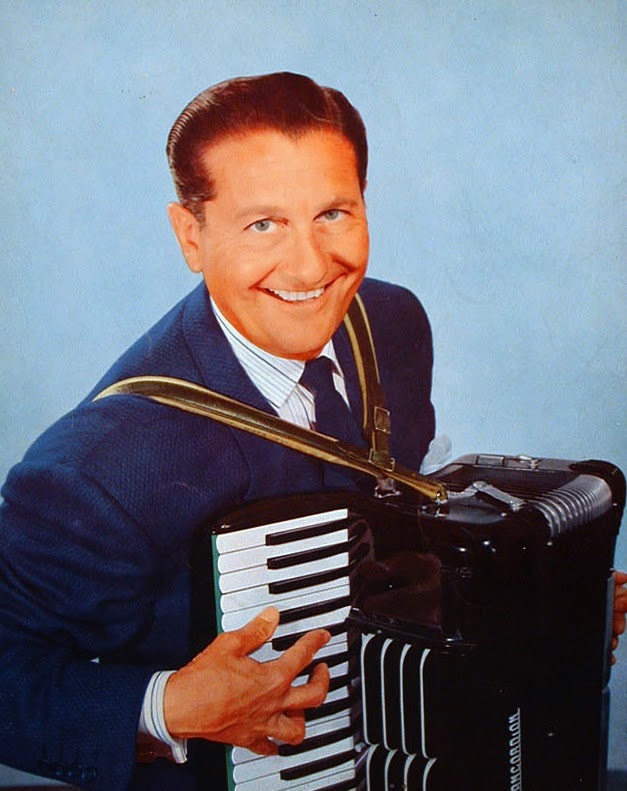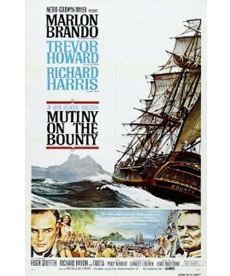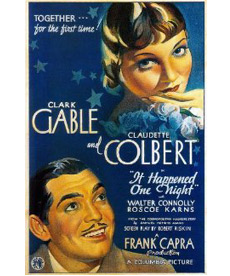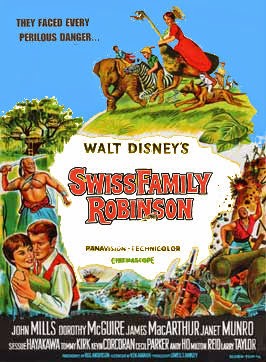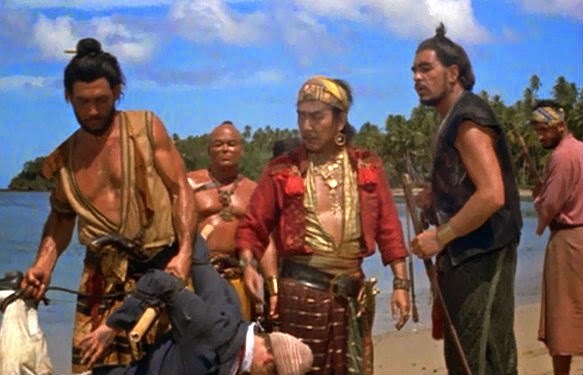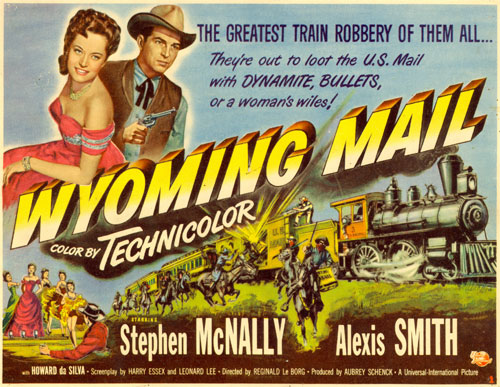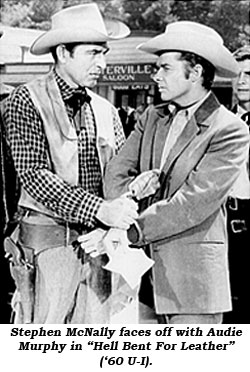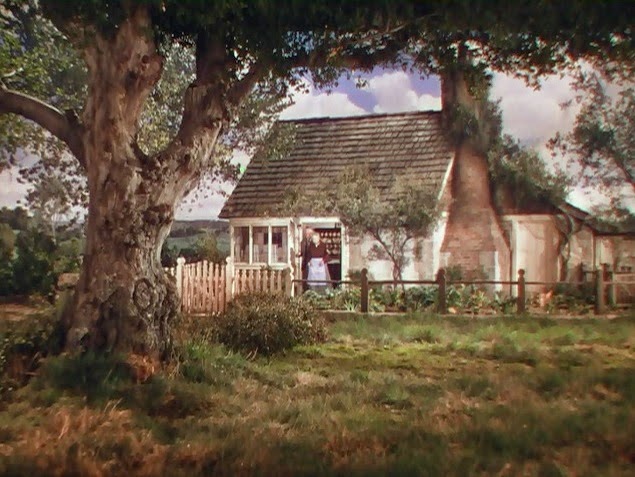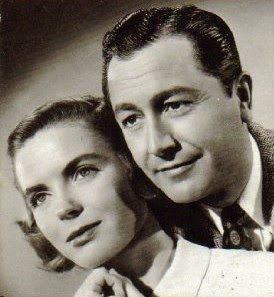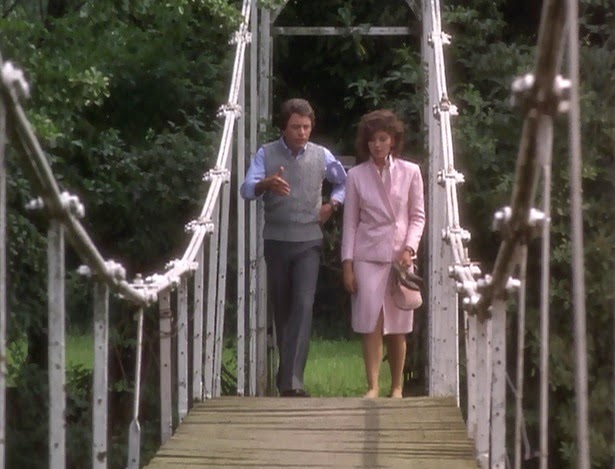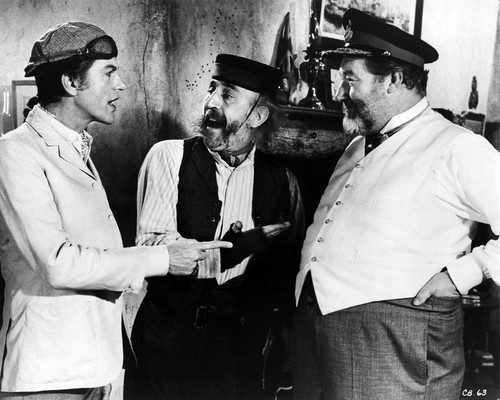Every Saturday night at 7pm a myriad of loyal fans gather around in front of their television screens to watch an American institution unfold. A fanfare of trumpets heralds the approaching wave of bubbles that float down upon the screen, each one bearing the face of an old familiar friend, with the last - and largest bubble - featuring the grinning face of the music maestro himself - Lawrence Welk.
This effervescent pageant of sudsy splendor is PBS's tacked on opening to that wunderbar institution known as The Lawrence Welk Show. Ever since The Lawrence Welk Show first aired in 1955, watching it has become a sacred ritual in many a home and, to be honest, Saturday night would just not be complete without this ritual, for The Lawrence Welk Show manages to capture feelings of summer days, Disneyland, good ol' fashioned fun, southern California, and the spirit of a patriotic America all within one short hour, every week. It's a satisfying program that is hard for one to resist.
The Lawrence Welk Show was one of the longest running variety shows on television, running for 27 years and still airing today on PBS. It featured dancing, singing and plenty of band music in all forms : big band, jive, jazz, country, polka, Latin, pop, gospel and, of course, champagne music. Welk's music has a lilting quality that is delightfully light and bubbly and - almost - tickles your nose.
The majority of the younger generation of today would consider the show, and the music being played, old people's entertainment but strangely, these "old people" watching the show today were young people forty years ago who lamented the same fact.
If you still have your teeth, and most of your hair strands intact, and thrive on this wunnerfully hokey show then don't be all too ashamed, or amazed, at your peculiar tastes. There are thousands, if not hundreds of thousands, of Welkies across America who love it too...and new fans are being born every leap year.
What makes this show so darn appealing? Welk was infectiously joyous, as was the rest of the cast. Those watching his show feel that they are meeting up with old friends at the "same place, same time" to share some laughs, goof around, sing and dance and have a whale of a good time. You could come as you like and would always be welkome. Bubbles, colorful settings, beautiful gals in beautiful dresses ( thanks to the talent of costume designer Rose Weiss ), handsome men in matching suits ( or the occasional kilt ), and plenty of music makes the show an addictive pleasure to behold.
It is indeed a corny show, but that is exactly what makes it so fun to watch. In an age when violence and distasteful humor are prevalent, it's good to sit down to a program that has a healthy atmosphere. Lawrence wanted a show that was full of good clean entertainment, and he never let anything slip into his program that wasn't suitable for children to watch.
Let's take a look now at how the show has evolved over the years and see how many familiar faces you can recognize :
Lawrence came from a family of German immigrants and was born in the mostly-German city of Strasburg, North Dakota. He grew up speaking only his mother tongue, until he went to school, where he failed to lose his heavy accent. At the age of 16 Welk asked his father to buy him a $400 accordion ( the equivalent of about $5000 today ) and for the next four years he worked on his parent's farm and performed at local functions to pay it off. In 1927 he formed his first band and they traveled across the Midwest performing one night stands. In 1939 the Welk Orchestra hit it big when they were hired to perform at the Trianon Ballroom in Chicago. The band was featured in a few Hollywood short films when they moved out to California.
In 1951, The Lawrence Welk band was signed for a 4-week engagement at the Aragon ballroom at Venice Beach, but were such a sensation that they stayed on....for four years! Audience members found out just how addictive champagne music can be. When the crowds on some nights numbered over five thousand, the manager of a Los Angeles television station, KTLA, took notice and asked Welk if the band would like to appear on television.
The Lawrence Welk Show - filmed live from the Aragon - aired on May 11, 1951 and lasted until 1955, when the show was picked up by ABC and aired nationally. On July 2, 1955 the Dodge Dancing Party ( their sponsor, Dodge, renamed the show of course ) debuted and across the nation future grannies thrilled at the toe-tapping beat emitting from their teletubes.
After testing out various title's in the late 1950s ( Lawrence Welk Presents Top Tunes and New Talents: The Lawrence Welk Plymouth Show ) it was renamed The Lawrence Welk Show for its 1960 season and remains so till this day.
Performers of the 1950s :
The Lawrence Welk Band - Welk's band was composed of some of the greatest clarinet-tooters and horn-blowers of the 20th century. Many of his band members were emigrants from dismembered big bands of the glorious jitterbuggin' days of the 1940s : Russ Klein of Freddy Martin's Orchestra; "Peanuts" Hucko of Glenn Miller's Army band, Barney Liddell of Glen Gray and his Casa Loma Orchestra, and Bob Havens, trombonist for the Benny Goodman Orchestra. Other notable band members included Big Tiny Little, Bob Ralston, Richard Maloof, Henry Cuesta, Frank Scott, Joe Livoti and Pete Fountain.
Welk loved to have his audience get to know the band members better and would frequently spotlight them with solo performances... much to their embarrassment. He also liked to test out their comedic, dancing, or vocal abilities. On many occasions these band members surprised him by being quite multi-talented and they would then find themselves singing in many a skit. Dick Dale, Bob Lido, Larry Hooper, and Rocky Rockwell were all band players who found themselves doing solos.
Aladdin -Aladdin Pallante was Welk's resident violinist during the 1950s and he stayed with the group until he suffered a heart attack in 1967. Before joining Welk's orchestra Aladdin had his own band and often performed with Rudy Vallee and Ray Noble. If his face looks familiar it's because Aladdin has appeared in over 100 films as well. Aladdin was usually placed in skits with the Lennon sisters, or in comedy routines with his fellow violinists Bob Lido and Dick Kesner. When he was not fiddling away on his magic violin, Aladdin enjoyed reciting speeches and poetry on air. In 1964 Dot Records released a compilation called "Words of Inspiration by Aladdin" featuring audience-favorite recitations.
Jimmy Roberts - The Kentucky born crooner "Gentleman Jim" got his start with Welk in 1954 and was such a fan favorite that he remained until the series ended in 1982. When he wasn't leaving behind his heart in San Francisco, Jimmy could be found beside the Champagne Lady giving her subtle, but ample support, in religious melodies and Jeanette MacDonald and Nelson Eddy renditions.
Alice Lon - When Welk's popular Champagne Lady, Roberta Linn left the band in 1953 to do a CBS radio show, Welk hosted a nationwide search for a new champagne lady and little Alice Lon from Kilgore, Texas, auditioned for the coveted spot. She won it. And she remained with the band for five years before leaving. Rumor had it that Welk fired her because she was showing "too much knee" but Lon admitted that she left because she was looking for a better paying job and wanted to sing spunkier songs as well. Big Tiny Little left the same time as Lon in search of a career as a solo artist.
Natalie Nevins- The lovely Natalie Nevins studied opera in New York and Hollywood before landing a gig as the star of a weekly television program, Notes from Natalie. This show earned the attention of Ed Sullivan who featured Nevins on his program. After doing other guest TV spots and nightclub performances Natalie auditioned for Welk ( over the telephone ) and got a spot on the Welk show in 1965. Her Barbie doll movements and beautiful pitch-perfect singing voice made her a very popular lady and she remained a regular member until 1970, when Welk fired her because she missed a live engagement.
Arthur Duncan - Duncan was the first African-American to join the cast in 1964, when he replaced Jack Imel as the star tap dancer. Duncan had traveled across Europe performing and was appearing at the Basin Street West in LA when he was spotted by the music Maestro's manager. Duncan was often paired with Imel and Bobby Burgess to form a tappin' trio in addition to his usual solo spot. In later decades Duncan enjoyed doing Bojangles routines. He also appeared in the tappin' film "TAP".
Jo Ann Castle - The popular lightning-fast ragtime piano player had a dark life hiding behind that bright and winsome smile. Castle joined with the Welk orchestra in 1959, first as an accordionist and then doing her ragtime solos. By 1969, however, Welk had fired her due to some off-screen publicity of the sort that he did not relish.
Today she still gathers with the gang for Welk performances in Branson.
Tanya Welk - Tanya Falan joined the Welk group in 1967 and shortly thereafter married Lawrence's son, Larry Jr. Tanya had a deep soulful voice and often performed Petula Clark or Dusty Springfield melodies. This Italian gal stayed on with the show until 1977, when she left to raise her three children. In 1979 she divorced Welk and has since remarried and gone on to be a interior designer.
The Blenders - The Blenders were composed of Bob Duncan ( the grinning blonde who looks like an ex-prize fighter ), Steve Smith, Greg Dickson and Johnny Johnson. The Blenders blended their voices into harmonic melodies in 1967 but unfortunately, they lasted only one season. Lead singer Steve Smith remained with the Welk show as a soloist until 1969. Off screen he dated Jo Ann Castle.
The Champagne Lady : Norma Zimmer - The lovely Norma Zimmer began her singing career doing voice-overs for non-singing Hollywood stars and performed with a number of vocal groups such as the Ken Darby singers, Alfred Newman and the Norma Luboff Choir. The Welk Orchestra was performing for two years without a champagne lady, until Norma Zimmer came into their lives in 1960. Zimmer had a canary-like soprano singing voice and often warbled Julie Andrews or Jeanette MacDonald tunes, much to the pleasure of Welk.
Bobby Burgess - Cheerful Bobby whirled onto the Welk stage in 1961 with his first partner Barbara Boylan, after winning a nationwide Calcutta dance competition. Welk was so pleased with the peppy twosome that he spotlighted them on the show on a weekly basis, and they quickly became fan favorites. When Boylan left in 1967, Cissy King replaced her. Elaine Balden was his final dance partner on the show up until 1982. If Bobby's smile is infectious it's because he had good training as one of the original Mousekateers on Walt Disney's The Mickey Mouse Club.
Joe Feeney - This Irish tenor joined the gang in 1957 and, he too, was such a fan favorite that he remained till 1982. Feeney always admitted that he never had vocal training, but that never stopped him from belting out many an Irish tune. He was often accompanied by Bob Ralston on the organ.
Andra Willis - Willis was the original Mexican senorita before Anacani arrived on the scene. Originally, she was hired as a replacement for the Lennon Sisters but with her skill in Latin languages Welk often tossed her South American tunes. Willis had a beautiful voice but sadly, left the show 1969, after only two years on television, to get married ( to Elvis Presley's keyboardist Larry Muhoberac ).
Jack Imel - Fresh out of the Navy, Jack Imel joined the Lawrence Welk Show in 1957 as a tap-dancing marimba player. His love for comedy led him to perform in other skits as a spoon or triangle player. Later, in 1965 he became the associate producer of the show. During the 1960s he was paired with Bobby Burgess in tap routines and later with Mary Lou Metzger in singing performances as well.
_____________________________________________________________
The 1970s brought about some changes with the format of The Lawrence Welk Show. "Champagne music" was rarely heard, instead, more and more skits were being used to back up singers performances, many embarrassingly corny. Myron Floren took over some of the m/c work since Welk's heavy accent was strangely worsening as the years progressed.
By the time the show celebrated their 20th anniversary it was already becoming known as a fad among the elderly and whenever a member left the cast the fan magazines were quick to bring out news of Welk giving them the whip. He had been known to get a wrap for being a hard taskmaster, but as he once explained to a reporter : "What you folks hear out there sometimes is from people who know nothing about it. The writers who create a story like that, they get a little more print. I've never been a person to lower the boom on people. If I was, they wouldn't stay with me."
"From Hollywood, the Lawrence Welk network presents...."
Welk was known for not having contracts with any one of his band members, but instead made a deal with a simple handshake. He preferred that they stay because they enjoyed their work, rather then for the reason of fulfilling a specified contract.
In 1972 ABC dropped The Lawrence Welk Show from their network but this did not stop Welk from blowing his bubbles. Instead, he became a producer and taped the show for syndication through Don Fedderson Productions ( My Three Sons, Family Affair ). It went on to become more popular than when ABC aired it.
Performers of the 1970s :
Guy and Ralna - Texan-born Ralna English first joined the gang in 1969 and soon after brought along her Tennessee husband Guy Hovis. The husband-wife team were probably the most popular performers on the Welk show during the 1970s and would frequently perform not one, but two (! ) numbers during the show, usually as a team and with one doing a solo. Today they still perform at Welk reunion concerts together even though they are no longer married.
Tom Netherton - This handsome German-born lad was one of the Welk's shows most popular leading singers. Tom first appeared on the show during the 1973 Christmas episode and stay until 1981. His rich baritone voice was also heard on off-Broadway productions of Carousel and Oklahoma!.
Kathie Sullivan - Wisconsin-born Kathie Sullivan was spotted by Welk after she won a Miss Champagne Music contest while attending the University of Wisconsin and joined the group as a full-fledged member in 1976, staying on until the show ended in 1982. Sullivan was once engaged to comedian Andy Kaufman. Today she still performs in between working as a bus driver for a retirement community.
![]()
Clay Hart - With Lynn Anderson leaving the show to start her own solo singing career, Welk felt another big country singer was needed and, in 1969, he hired Clay Hart, whom he considered to be one of the best "contry sengers in the contry". Hart was a John-Davidson-type whom enjoyed performing Glenn Campbell tunes. He left the show in 1975 after marrying Sally Flynn.
The Simonski Sisters - These gals were Welk's answer to the new Lennon Sisters. Alas, with a name like Simonski they didn't take off as well as hoped. Nevertheless they had a good run while they were on air, which was between 1975-1977. The sisters six included Diane, Donna, Jo Anne, Valerie, Audrey, and Michelle.
Ken Delo - Delo was one half of the team Delo and Daly, a popular Martin & Lewis style comedy act that enjoyed success in Australia in 1960-1961 with their own television series. The team broke up the following year and Delo did some guest appearances before Arthur Duncan invited him to appear on The Lawrence Welk Show in 1969. Positive viewer response brought Delo back for three more guest appearances before he became a regular performer.
The Aldrich Sisters - Sheila and Sherry Aldrich were flight attendants before they decided to give show business a try. They auditioned for Welk in 1977 and were given a lucky break when Tanya Welk left the show and an opening needed to be filled. They were often confused as being twins since they were paired with the Otwell twins but in fact the singing hostesses are two years apart.
The Otwell Twins - The happy-go-lucky Otwell Twins ( Roger and David ) joined the show the same year as the Aldrich sisters. Since there was only an opening for one act, they were teamed with the Aldrich sisters and made a great foursome. Today they live in Texas with their families and still perform at various functions, always with their trusty Martin guitars to back them up.
Anacani - The "little Mexican senorita", as Welk liked to call Anacani, first appeared with the band in 1972 when she was invited to sing before the audience after Welk had seen her perform at his Escondido resort. Anacani loved to sway to the music and often glided across the stage like Carmen Mirando to a bossa nova beat.
Jim Turner - When Clay Hart left the show, another male country singer was needed and it was not long before audiences saw Jim Turner croonin' lonesome polecat tunes into his microphone during the 1979 season. Jim Turner was paired with Ava Barber for quite a few duets. After Welk, Turner headlined his own shows at Knotts Berry Farm and has since performed in Nashville.
Mary Lou Metzger, Gail Farrell - These two gals were the background singers on the show, often filling in whenever they were needed to complete a three-some or a four-some. Mary Lou Metzger had a flair for dancing and was put into a number of comedy skits. She rarely performed solo, unless she was backed by the Hotsy Tot Boys. Metzger is most famous for hosting the PBS introductions to the Welk re-runs every Saturday. Farrell was an accomplised singer as well as a pianist. When Sandi left the show, she brought in her husband Ron and his friend Michael and they formed a trio.
Ava Barber - Barber was the resident country singer on the Welk show and whenever a Patsy Cline, Loretta Lynn, or Tammy Wynette tune needed a new rendition, Ava would oblige. The tall blonde joined the cast in 1974 and enjoyed playing in skits as well and was quite a versatile singer when she was given the chance. Today Barber tours with the Wunnerful Women of Welk shows.
Sally and Sandy - Sally Flynn and Sandi Griffiths started singing together when they both attended Brigham Young University. They performed at Disneyland, Vietnam ( with the USO tour ) and as the opening act for Jack Jones at Harrah's in Lake Tahoe. This was their big break and Welk spotted them during these performances and asked them to appear on his show in 1968. When Sally left the group to marry Clay Hart, Sandi remained until 1980.
There weren't all that many companies that were willing to gamble and put Welk's face on their products to sell their merchandise. After all, what child would humiliate himself among his school-friends carrying a Lawrence Welk lunchbox or a Lawrence Welk doll?
Welk's show was a promotional tool in itself. Sponsors proudly hung their giant lettering on the curtains behind the orchestra. Dodge and Gerital were the most popular sponsors of the show and their companies catered to Welk's middle age audience members. Welk loved promoting his stars and just about all of them released albums of their "greatest hits" or "favorite hymns".
"Feel Stronger Fast...with Geritol!"
For those ardent Welkies who would like to collect some great fan memorabilia there are plenty of paraphernalia out there even without the merchandise tie-in products. The members of the band were always hot publicity and Radio/TV Mirror, Photoplay and TV Star Parade frequently plastered them on their covers. Also, there are a plethora of brochures, TV Guide covers ( Welk appeared on no less than ten! ), coloring books, Whitman story books, postcards, TV trays ( very clever ), photos, buttons, flyers, matchbook covers, and even paper dolls to collect....of the Lennon sisters of course. Alas, no paper doll company was bold enough to released an undie-clad Mr.Welk doll.
When Welk and the musical family were finished preparing their performances for the season's program, they could be found on the road touring across the nation, or performing at one of Welk's wunnerful resorts in California. He certainly had plenty of them.
Welk was quite a businessman and he had a veritable mob working for him. He opened his own bank for his band members to keep their money in, owned the hotel and apartments that they would stay at, and opened his own country club and resort. Welk's personal home was a sprawling mid-century modern Sinatra-style spread in Palm Springs.
Every summer the orchestra and the singers gathered at Harrah's on Lake Tahoe for a three-week engagement, and when they weren't here they were performing at the Palladium in Hollywood. Like a true stage-mother hen, Welk was always keeping a keen eye out for new performers that he could gather to his growing flock and often visited his resorts to listen to these new singers croon a few tunes.
The Norma Zimmer Show - November 13, 1965
A loving tribute episode to the Champagne Lady, featuring some beautiful melodies from the orchestra as well as these tunes, sung by the performers : Lida Rose, Tammy, Latin Prayer and Pick Yourself Up.
Country and Western Music - March 9, 1968
This fun episodes features the music of the west, and some grand music it was too! Zimmer sings The Wayward Wind, Steve Smith does a great rendition of Hear Comes Heaven and Dick Dale sings If I Could See the World Through the Eyes of a Child.
Strike Up the Band - May 16, 1964
A medley of great band tunes could be heard in this episode, including This Could Be the Start of Something Big, The World is Waiting for the Sunrise. Joe Feeney does a beautiful rendition of Little Grey Home in the West.
We hope you've enjoyed our spotlight of The Lawrence Welk Show. Until we see you again, keep a song in your heart!
" Good night, sleep tight and pleasant dreams to you. Here's a wish and a prayer that every dream comes true. And now, till we meet again...Adios, Au Revoir, Auf Wiedersehen, Good Night! "
This effervescent pageant of sudsy splendor is PBS's tacked on opening to that wunderbar institution known as The Lawrence Welk Show. Ever since The Lawrence Welk Show first aired in 1955, watching it has become a sacred ritual in many a home and, to be honest, Saturday night would just not be complete without this ritual, for The Lawrence Welk Show manages to capture feelings of summer days, Disneyland, good ol' fashioned fun, southern California, and the spirit of a patriotic America all within one short hour, every week. It's a satisfying program that is hard for one to resist.
The Lawrence Welk Show was one of the longest running variety shows on television, running for 27 years and still airing today on PBS. It featured dancing, singing and plenty of band music in all forms : big band, jive, jazz, country, polka, Latin, pop, gospel and, of course, champagne music. Welk's music has a lilting quality that is delightfully light and bubbly and - almost - tickles your nose.
The majority of the younger generation of today would consider the show, and the music being played, old people's entertainment but strangely, these "old people" watching the show today were young people forty years ago who lamented the same fact.
If you still have your teeth, and most of your hair strands intact, and thrive on this wunnerfully hokey show then don't be all too ashamed, or amazed, at your peculiar tastes. There are thousands, if not hundreds of thousands, of Welkies across America who love it too...and new fans are being born every leap year.
What makes this show so darn appealing? Welk was infectiously joyous, as was the rest of the cast. Those watching his show feel that they are meeting up with old friends at the "same place, same time" to share some laughs, goof around, sing and dance and have a whale of a good time. You could come as you like and would always be welkome. Bubbles, colorful settings, beautiful gals in beautiful dresses ( thanks to the talent of costume designer Rose Weiss ), handsome men in matching suits ( or the occasional kilt ), and plenty of music makes the show an addictive pleasure to behold.
It is indeed a corny show, but that is exactly what makes it so fun to watch. In an age when violence and distasteful humor are prevalent, it's good to sit down to a program that has a healthy atmosphere. Lawrence wanted a show that was full of good clean entertainment, and he never let anything slip into his program that wasn't suitable for children to watch.
Let's take a look now at how the show has evolved over the years and see how many familiar faces you can recognize :
A Look Back
In 1951, The Lawrence Welk band was signed for a 4-week engagement at the Aragon ballroom at Venice Beach, but were such a sensation that they stayed on....for four years! Audience members found out just how addictive champagne music can be. When the crowds on some nights numbered over five thousand, the manager of a Los Angeles television station, KTLA, took notice and asked Welk if the band would like to appear on television.
1950s
The Lawrence Welk Show - filmed live from the Aragon - aired on May 11, 1951 and lasted until 1955, when the show was picked up by ABC and aired nationally. On July 2, 1955 the Dodge Dancing Party ( their sponsor, Dodge, renamed the show of course ) debuted and across the nation future grannies thrilled at the toe-tapping beat emitting from their teletubes.
After testing out various title's in the late 1950s ( Lawrence Welk Presents Top Tunes and New Talents: The Lawrence Welk Plymouth Show ) it was renamed The Lawrence Welk Show for its 1960 season and remains so till this day.
Performers of the 1950s :
The Lawrence Welk Band - Welk's band was composed of some of the greatest clarinet-tooters and horn-blowers of the 20th century. Many of his band members were emigrants from dismembered big bands of the glorious jitterbuggin' days of the 1940s : Russ Klein of Freddy Martin's Orchestra; "Peanuts" Hucko of Glenn Miller's Army band, Barney Liddell of Glen Gray and his Casa Loma Orchestra, and Bob Havens, trombonist for the Benny Goodman Orchestra. Other notable band members included Big Tiny Little, Bob Ralston, Richard Maloof, Henry Cuesta, Frank Scott, Joe Livoti and Pete Fountain.
Welk loved to have his audience get to know the band members better and would frequently spotlight them with solo performances... much to their embarrassment. He also liked to test out their comedic, dancing, or vocal abilities. On many occasions these band members surprised him by being quite multi-talented and they would then find themselves singing in many a skit. Dick Dale, Bob Lido, Larry Hooper, and Rocky Rockwell were all band players who found themselves doing solos.
Aladdin -Aladdin Pallante was Welk's resident violinist during the 1950s and he stayed with the group until he suffered a heart attack in 1967. Before joining Welk's orchestra Aladdin had his own band and often performed with Rudy Vallee and Ray Noble. If his face looks familiar it's because Aladdin has appeared in over 100 films as well. Aladdin was usually placed in skits with the Lennon sisters, or in comedy routines with his fellow violinists Bob Lido and Dick Kesner. When he was not fiddling away on his magic violin, Aladdin enjoyed reciting speeches and poetry on air. In 1964 Dot Records released a compilation called "Words of Inspiration by Aladdin" featuring audience-favorite recitations.
Jimmy Roberts - The Kentucky born crooner "Gentleman Jim" got his start with Welk in 1954 and was such a fan favorite that he remained until the series ended in 1982. When he wasn't leaving behind his heart in San Francisco, Jimmy could be found beside the Champagne Lady giving her subtle, but ample support, in religious melodies and Jeanette MacDonald and Nelson Eddy renditions.
Alice Lon - When Welk's popular Champagne Lady, Roberta Linn left the band in 1953 to do a CBS radio show, Welk hosted a nationwide search for a new champagne lady and little Alice Lon from Kilgore, Texas, auditioned for the coveted spot. She won it. And she remained with the band for five years before leaving. Rumor had it that Welk fired her because she was showing "too much knee" but Lon admitted that she left because she was looking for a better paying job and wanted to sing spunkier songs as well. Big Tiny Little left the same time as Lon in search of a career as a solo artist.
________________________________________________________
________________________________________________________________
The Lennon Sisters
The Lennon sisters were undoubtedly The Lawrence Welk Show's most famous singing stars, in fact, they enticed many a young viewer to sit beside their parents and watch the show. The sparkling sisters were Dianne ( the eldest ), Peggy, Kathy, and little Janet. In 1968, all four of the gals left the show to team up with the ol' Schnozzola in Jimmy Durante Presents the Lennon Sisters, where they sang, danced, and hosted a variety of entertainers including Jack Benny, Bob Hope, Phyllis Diller, and Neil Harrison. The murder of their father just prior to filming the show may have contributed to it lasting for only one season. During the 1970s they performed regularly on the Andy Willams Show and toured across the country. Kathy, Janet, and Mimi ( their younger sister ) still perform today.
1960s
The 1960s were the hey-days for The Lawrence Welk Show. The program offered easy-listening escapism from the problems of the late 1960s. On the show, Vietnam disappeared, drugs were a non-existent problem, and violence was unheard of. The Nielsen ratings ranked the show at #12 in the nation in 1965. A new addition to the show was the creation of sets, used as backdrops for the entertainers to perform with. These eventually led to all-out skits.
This decade also brought a wave of new musicians and great talent in the music industry and Welk played all of the new hits as fast as the composers were penning them. The music of Mancini and Bacharach were particular favorites of his. Welk had more records on the Billboard Top 100 chart than any other big band during the rock and roll era. His biggest hits, "Calcutta" and "Baby Elephant Walk", remained on the charts for 17 weeks.
Performers of the 1960s :
This decade also brought a wave of new musicians and great talent in the music industry and Welk played all of the new hits as fast as the composers were penning them. The music of Mancini and Bacharach were particular favorites of his. Welk had more records on the Billboard Top 100 chart than any other big band during the rock and roll era. His biggest hits, "Calcutta" and "Baby Elephant Walk", remained on the charts for 17 weeks.
Performers of the 1960s :
Natalie Nevins- The lovely Natalie Nevins studied opera in New York and Hollywood before landing a gig as the star of a weekly television program, Notes from Natalie. This show earned the attention of Ed Sullivan who featured Nevins on his program. After doing other guest TV spots and nightclub performances Natalie auditioned for Welk ( over the telephone ) and got a spot on the Welk show in 1965. Her Barbie doll movements and beautiful pitch-perfect singing voice made her a very popular lady and she remained a regular member until 1970, when Welk fired her because she missed a live engagement.
Arthur Duncan - Duncan was the first African-American to join the cast in 1964, when he replaced Jack Imel as the star tap dancer. Duncan had traveled across Europe performing and was appearing at the Basin Street West in LA when he was spotted by the music Maestro's manager. Duncan was often paired with Imel and Bobby Burgess to form a tappin' trio in addition to his usual solo spot. In later decades Duncan enjoyed doing Bojangles routines. He also appeared in the tappin' film "TAP".
Jo Ann Castle - The popular lightning-fast ragtime piano player had a dark life hiding behind that bright and winsome smile. Castle joined with the Welk orchestra in 1959, first as an accordionist and then doing her ragtime solos. By 1969, however, Welk had fired her due to some off-screen publicity of the sort that he did not relish.
Today she still gathers with the gang for Welk performances in Branson.
Tanya Welk - Tanya Falan joined the Welk group in 1967 and shortly thereafter married Lawrence's son, Larry Jr. Tanya had a deep soulful voice and often performed Petula Clark or Dusty Springfield melodies. This Italian gal stayed on with the show until 1977, when she left to raise her three children. In 1979 she divorced Welk and has since remarried and gone on to be a interior designer.
The Blenders - The Blenders were composed of Bob Duncan ( the grinning blonde who looks like an ex-prize fighter ), Steve Smith, Greg Dickson and Johnny Johnson. The Blenders blended their voices into harmonic melodies in 1967 but unfortunately, they lasted only one season. Lead singer Steve Smith remained with the Welk show as a soloist until 1969. Off screen he dated Jo Ann Castle.
The Champagne Lady : Norma Zimmer - The lovely Norma Zimmer began her singing career doing voice-overs for non-singing Hollywood stars and performed with a number of vocal groups such as the Ken Darby singers, Alfred Newman and the Norma Luboff Choir. The Welk Orchestra was performing for two years without a champagne lady, until Norma Zimmer came into their lives in 1960. Zimmer had a canary-like soprano singing voice and often warbled Julie Andrews or Jeanette MacDonald tunes, much to the pleasure of Welk.
Bobby Burgess - Cheerful Bobby whirled onto the Welk stage in 1961 with his first partner Barbara Boylan, after winning a nationwide Calcutta dance competition. Welk was so pleased with the peppy twosome that he spotlighted them on the show on a weekly basis, and they quickly became fan favorites. When Boylan left in 1967, Cissy King replaced her. Elaine Balden was his final dance partner on the show up until 1982. If Bobby's smile is infectious it's because he had good training as one of the original Mousekateers on Walt Disney's The Mickey Mouse Club.
Joe Feeney - This Irish tenor joined the gang in 1957 and, he too, was such a fan favorite that he remained till 1982. Feeney always admitted that he never had vocal training, but that never stopped him from belting out many an Irish tune. He was often accompanied by Bob Ralston on the organ.
Andra Willis - Willis was the original Mexican senorita before Anacani arrived on the scene. Originally, she was hired as a replacement for the Lennon Sisters but with her skill in Latin languages Welk often tossed her South American tunes. Willis had a beautiful voice but sadly, left the show 1969, after only two years on television, to get married ( to Elvis Presley's keyboardist Larry Muhoberac ).
Jack Imel - Fresh out of the Navy, Jack Imel joined the Lawrence Welk Show in 1957 as a tap-dancing marimba player. His love for comedy led him to perform in other skits as a spoon or triangle player. Later, in 1965 he became the associate producer of the show. During the 1960s he was paired with Bobby Burgess in tap routines and later with Mary Lou Metzger in singing performances as well.
_____________________________________________________________
1970s
By the time the show celebrated their 20th anniversary it was already becoming known as a fad among the elderly and whenever a member left the cast the fan magazines were quick to bring out news of Welk giving them the whip. He had been known to get a wrap for being a hard taskmaster, but as he once explained to a reporter : "What you folks hear out there sometimes is from people who know nothing about it. The writers who create a story like that, they get a little more print. I've never been a person to lower the boom on people. If I was, they wouldn't stay with me."
"From Hollywood, the Lawrence Welk network presents...."
Welk was known for not having contracts with any one of his band members, but instead made a deal with a simple handshake. He preferred that they stay because they enjoyed their work, rather then for the reason of fulfilling a specified contract.
In 1972 ABC dropped The Lawrence Welk Show from their network but this did not stop Welk from blowing his bubbles. Instead, he became a producer and taped the show for syndication through Don Fedderson Productions ( My Three Sons, Family Affair ). It went on to become more popular than when ABC aired it.
Performers of the 1970s :
Guy and Ralna - Texan-born Ralna English first joined the gang in 1969 and soon after brought along her Tennessee husband Guy Hovis. The husband-wife team were probably the most popular performers on the Welk show during the 1970s and would frequently perform not one, but two (! ) numbers during the show, usually as a team and with one doing a solo. Today they still perform at Welk reunion concerts together even though they are no longer married.
Tom Netherton - This handsome German-born lad was one of the Welk's shows most popular leading singers. Tom first appeared on the show during the 1973 Christmas episode and stay until 1981. His rich baritone voice was also heard on off-Broadway productions of Carousel and Oklahoma!.
Kathie Sullivan - Wisconsin-born Kathie Sullivan was spotted by Welk after she won a Miss Champagne Music contest while attending the University of Wisconsin and joined the group as a full-fledged member in 1976, staying on until the show ended in 1982. Sullivan was once engaged to comedian Andy Kaufman. Today she still performs in between working as a bus driver for a retirement community.
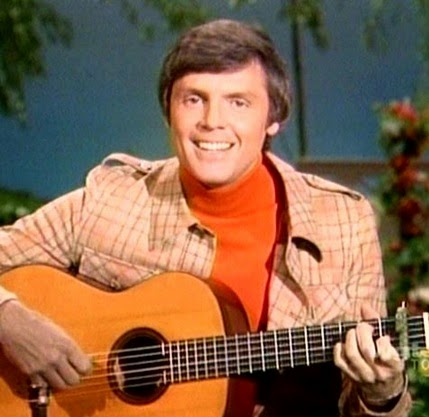
Clay Hart - With Lynn Anderson leaving the show to start her own solo singing career, Welk felt another big country singer was needed and, in 1969, he hired Clay Hart, whom he considered to be one of the best "contry sengers in the contry". Hart was a John-Davidson-type whom enjoyed performing Glenn Campbell tunes. He left the show in 1975 after marrying Sally Flynn.
_____________________________________________________________
The Simonski Sisters - These gals were Welk's answer to the new Lennon Sisters. Alas, with a name like Simonski they didn't take off as well as hoped. Nevertheless they had a good run while they were on air, which was between 1975-1977. The sisters six included Diane, Donna, Jo Anne, Valerie, Audrey, and Michelle.
Ken Delo - Delo was one half of the team Delo and Daly, a popular Martin & Lewis style comedy act that enjoyed success in Australia in 1960-1961 with their own television series. The team broke up the following year and Delo did some guest appearances before Arthur Duncan invited him to appear on The Lawrence Welk Show in 1969. Positive viewer response brought Delo back for three more guest appearances before he became a regular performer.
The Aldrich Sisters - Sheila and Sherry Aldrich were flight attendants before they decided to give show business a try. They auditioned for Welk in 1977 and were given a lucky break when Tanya Welk left the show and an opening needed to be filled. They were often confused as being twins since they were paired with the Otwell twins but in fact the singing hostesses are two years apart.
The Otwell Twins - The happy-go-lucky Otwell Twins ( Roger and David ) joined the show the same year as the Aldrich sisters. Since there was only an opening for one act, they were teamed with the Aldrich sisters and made a great foursome. Today they live in Texas with their families and still perform at various functions, always with their trusty Martin guitars to back them up.
Anacani - The "little Mexican senorita", as Welk liked to call Anacani, first appeared with the band in 1972 when she was invited to sing before the audience after Welk had seen her perform at his Escondido resort. Anacani loved to sway to the music and often glided across the stage like Carmen Mirando to a bossa nova beat.
Jim Turner - When Clay Hart left the show, another male country singer was needed and it was not long before audiences saw Jim Turner croonin' lonesome polecat tunes into his microphone during the 1979 season. Jim Turner was paired with Ava Barber for quite a few duets. After Welk, Turner headlined his own shows at Knotts Berry Farm and has since performed in Nashville.
Mary Lou Metzger, Gail Farrell - These two gals were the background singers on the show, often filling in whenever they were needed to complete a three-some or a four-some. Mary Lou Metzger had a flair for dancing and was put into a number of comedy skits. She rarely performed solo, unless she was backed by the Hotsy Tot Boys. Metzger is most famous for hosting the PBS introductions to the Welk re-runs every Saturday. Farrell was an accomplised singer as well as a pianist. When Sandi left the show, she brought in her husband Ron and his friend Michael and they formed a trio.
Ava Barber - Barber was the resident country singer on the Welk show and whenever a Patsy Cline, Loretta Lynn, or Tammy Wynette tune needed a new rendition, Ava would oblige. The tall blonde joined the cast in 1974 and enjoyed playing in skits as well and was quite a versatile singer when she was given the chance. Today Barber tours with the Wunnerful Women of Welk shows.
Sally and Sandy - Sally Flynn and Sandi Griffiths started singing together when they both attended Brigham Young University. They performed at Disneyland, Vietnam ( with the USO tour ) and as the opening act for Jack Jones at Harrah's in Lake Tahoe. This was their big break and Welk spotted them during these performances and asked them to appear on his show in 1968. When Sally left the group to marry Clay Hart, Sandi remained until 1980.
Merchandise and Memorabilia
There weren't all that many companies that were willing to gamble and put Welk's face on their products to sell their merchandise. After all, what child would humiliate himself among his school-friends carrying a Lawrence Welk lunchbox or a Lawrence Welk doll?
Welk's show was a promotional tool in itself. Sponsors proudly hung their giant lettering on the curtains behind the orchestra. Dodge and Gerital were the most popular sponsors of the show and their companies catered to Welk's middle age audience members. Welk loved promoting his stars and just about all of them released albums of their "greatest hits" or "favorite hymns".
"Feel Stronger Fast...with Geritol!"
For those ardent Welkies who would like to collect some great fan memorabilia there are plenty of paraphernalia out there even without the merchandise tie-in products. The members of the band were always hot publicity and Radio/TV Mirror, Photoplay and TV Star Parade frequently plastered them on their covers. Also, there are a plethora of brochures, TV Guide covers ( Welk appeared on no less than ten! ), coloring books, Whitman story books, postcards, TV trays ( very clever ), photos, buttons, flyers, matchbook covers, and even paper dolls to collect....of the Lennon sisters of course. Alas, no paper doll company was bold enough to released an undie-clad Mr.Welk doll.
Off the Set
When Welk and the musical family were finished preparing their performances for the season's program, they could be found on the road touring across the nation, or performing at one of Welk's wunnerful resorts in California. He certainly had plenty of them.
Welk was quite a businessman and he had a veritable mob working for him. He opened his own bank for his band members to keep their money in, owned the hotel and apartments that they would stay at, and opened his own country club and resort. Welk's personal home was a sprawling mid-century modern Sinatra-style spread in Palm Springs.
Every summer the orchestra and the singers gathered at Harrah's on Lake Tahoe for a three-week engagement, and when they weren't here they were performing at the Palladium in Hollywood. Like a true stage-mother hen, Welk was always keeping a keen eye out for new performers that he could gather to his growing flock and often visited his resorts to listen to these new singers croon a few tunes.
Ah-One, Ah-Two, Ah-Three Favorite Episodes
A loving tribute episode to the Champagne Lady, featuring some beautiful melodies from the orchestra as well as these tunes, sung by the performers : Lida Rose, Tammy, Latin Prayer and Pick Yourself Up.
Country and Western Music - March 9, 1968
This fun episodes features the music of the west, and some grand music it was too! Zimmer sings The Wayward Wind, Steve Smith does a great rendition of Hear Comes Heaven and Dick Dale sings If I Could See the World Through the Eyes of a Child.
Strike Up the Band - May 16, 1964
A medley of great band tunes could be heard in this episode, including This Could Be the Start of Something Big, The World is Waiting for the Sunrise. Joe Feeney does a beautiful rendition of Little Grey Home in the West.
_________________________________________________________
" Good night, sleep tight and pleasant dreams to you. Here's a wish and a prayer that every dream comes true. And now, till we meet again...Adios, Au Revoir, Auf Wiedersehen, Good Night! "
